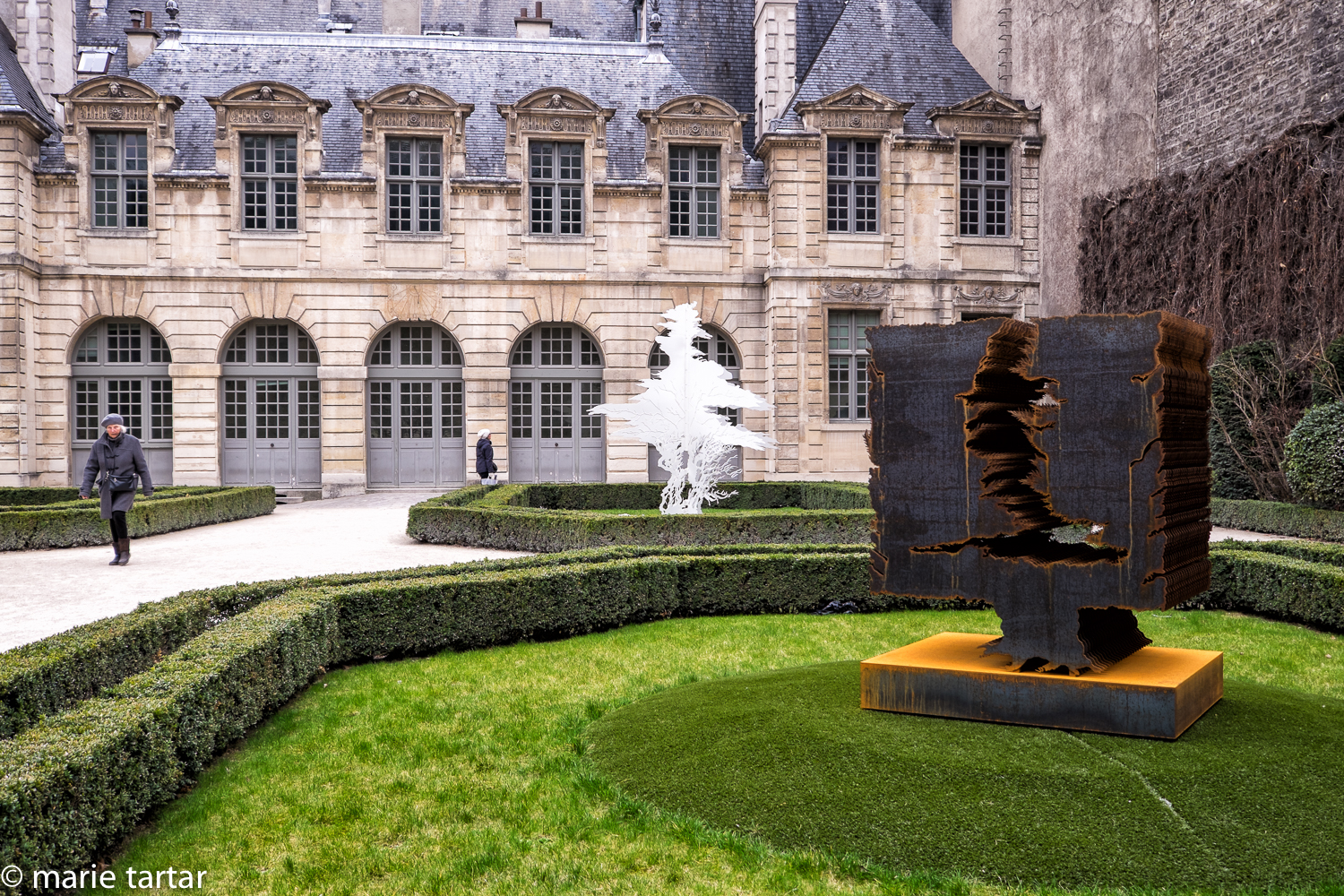
When people ask me why I am going to Paris alone, in March, the subtext seems to be:
“Again? Why?”
That’s not a hard question to answer, but to do so concisely, that’s more difficult.
If I had to pare it down to one phrase, it would be: Je me sens bonnes ici. (I feel good here.)
Or as my Francophile friend Margie put it, more eloquently:
“When I step off the plane, I feel 20 pounds lighter and 20 years younger!”
Coupled with adjusting to a recent semi-big birthday, this seems as good a reason as any. I have my “enabler” friend Cindy, with more time than she can use in her fabulously central Marais apartment, to thank for this stay. It was 6 years ago that I first spent more than a few days in Paris, then as now thanks to Cindy. I had decided that I wanted to stay in an apartment in Paris for 2 weeks for my 50th birthday, to really explore it. As it happened, I met Cindy and Gerry a few years before the big one, one thing led to another, and, they happened to offer me time in their apartment which coincided with my 49th birthday. Quelle coincidence, non? After that, the French bug bit me, but good. I returned home from that trip and enrolled in the Alliance Française. I’ve been able to measure my progress on subsequent trips by how long I can keep an English-speaking French person from switching to English.
This trip, an overnight to London after a Monday workday, was passed with the aid of an unusually good movie selection. Michael Keaton in “Birdman” deserved the many accolades he received, and I also enjoyed the Paris apartment-focused comedic drama “My Old Lady, ” with Maggie Smith, Kevin Kline and Kristen Scott Thomas.
I’ve learned to take only what I can manage myself (a backpack filled with camera gear and a carry-on roller), so as to be able to take the train and subway into the city with (relative) ease. The difficulty is if I fill up the Longchamps “Plier” extra bag I always bring, a souvenir of an earlier trip to Paris. This train trip was populated with a group of swarthy young men, probably of middle eastern origin, who all seemed to favor the same look: black quilted jacket and jeans. One young man in this uniform with a shaved head whittled away at his nails and cuticles with his teeth en route.
Wednesday, March 11, 2015
To prod me out of the apartment at a reasonable hour on my first morning, I had scheduled myself for a “Taste of the Marais” tour with Paris by Mouth at 10:30 am. We had met founder Meg Zimbeck years back, when she helped serve at the Hidden Kitchen, the occasional 10 course dinner with wine pairings, offered in their apartment by Laura and Braden, the couple who now run a favorite restaurant and wine bar, Verjus, in the 1st arrondisement. I was curious to sample one of their tastings, some of which sounded similar to offerings by Ô Chateau and Paris Walks, although generally more expensive, at 95 E for a 3 hour session.
The guide for our group of 7 Americans from Oregon, Tennessee and Michigan, was Jennifer, an American ex-pat from Washington State. We started at a boulangerie named for its address, 134 RdT, at 134 rue de Turenne. At its helm is a “hot” former accountant, Benjamin, whom we briefly glimpsed. In his second career, he has achieved considerable acclaim, for both his baguettes and croissants (still more unusual for excelling in both categories, bakers usually concentrating their efforts on one or the other). We sampled some of both, and they were indeed super! Jennifer pointed out the absence of bumps on the baguette’s base, bumps being a sure sign of mass production. The croissants displayed both the “crumbs-flying-everywhere” and the interior pinwheel signs of a good croissant. Many of our stops were clustered around the Marché des Enfants Rouge on rue de Bretagne. The fromagerie we visited is family run, a father and daughter operation, Fromagerie Jouannault. We learned some new vocabulary, including the term affineur, which refers to a person who is trained in cheese maturation. It signifies a fromagerie that doesn’t just sell cheese, but should be able to ensure that cheese is sold at the proper level of maturation.
Caractère de Cochon, around the corner on rue de Charlot, is a tiny joint, entirely devoted to cured meats, from France, as well as neighboring Spain and Italy.

Solo, not a “caratère de cochon” at all, is the charming proprietor of the tiny Haut Marais shop of the same name, devoted to cured meats
We learned another expression there: the name means bad character or person. I prefer to think of it as “pig-headed”. Apparently, one owner called Solo this as he rejected proposal after proposal for a name for the new business. The cubicle-sized space is filled with sausages, patés, and hams.
We tasted female and male hams, most preferring the “virginal” female.
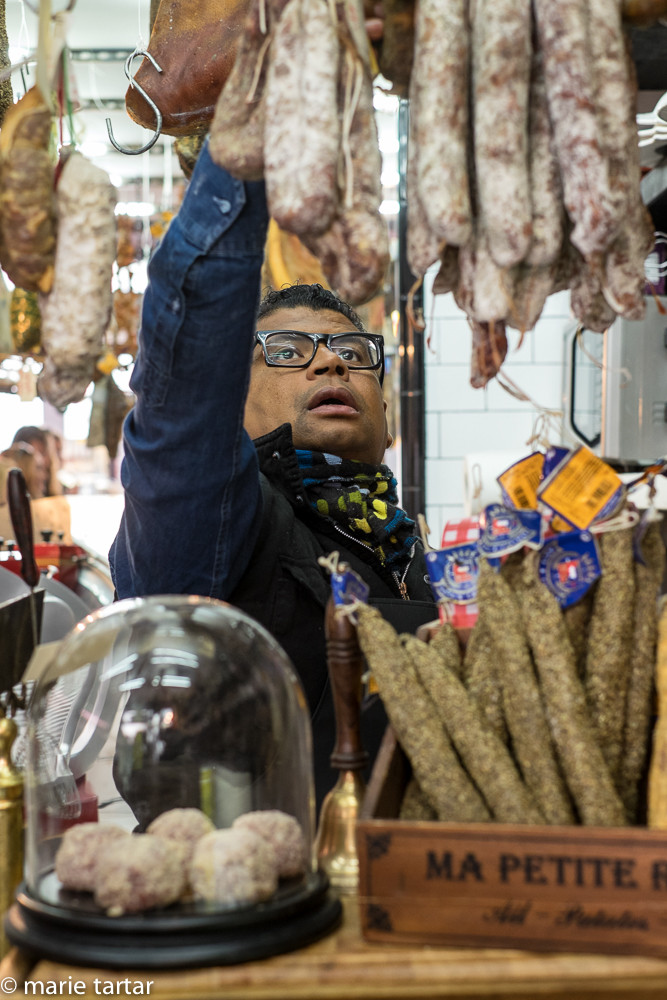
Solo surrounded by salamis; under the dome are snowballs (truffle stuffed saucisson rolled in parmesan)
A sausage and truffle “snowball” encrusted in parmesan was secured for later consumption, along with duck rillettes (a stewed meat spread, or “meat butter” as Jennifer put it) procured from the traiteur/charcuterie across the street, Maison Ramella. This tasting took place at an interesting wine store nearby, Bibo Vino, where all of the wine is sold in bags in boxes. They have even trademarked the phrase Bag in Box. Unlike earlier versions (I’m recalling mylar bags of New Zealand wine which warmed us on a windy and rainy multiday Routeburn Track trek years ago) , this new version allows the wine to last longer (a month or so). These wines are sourced from small producers. Packaging wine this way is touted as “more economical, practical and ecological.” The samples we tasted were delicious, enough so that I retraced our steps later in the day to stock the apartment.
Our tour concluded near where we started, at Jacques Genin, across the street from 134 RdT boulangerie. We had enjoyed this jewel shop of a chocolaterie on our last visit. We learned about the “rebel” owner’s remarkable life story, beginning at age 12, working in a slaughterhouse, and proceeding to owning his own restaurants, a stint as the head patissier at La Maison du Chocolat, to supplying chocolates and caramels to top hotels and restaurants, all without formal training. The sweet treats were gorgeous and equally delicious.
I had initially thought the price tag for the tasting, at 95 E, was a little pricey; I ended up thinking, at 3+ hours, including interesting commentary, insider information, and plenty of tastes and drinks, that it was a good value.
We ran over our planned 3 hours by a half-hour, making me a little tardy to meet my friend Patricia at the Picasso Museum, a few blocks away.

From the last time we were at the Picasso Museum, in 2009, just before the prolonged closure for renovation. The building was intersected by a mirrored Daniel Buren intervention; the colorful insets in the windows were also his doing. Old and new together, classic and contemporary, one of the many reasons j’adore Paris!
The Picasso Museum was closed for 5 years for an extensive renovation, and had reopened just before our last trip in November, but there had been no time during that short visit. One nice new addition is Le café sur le Toit (Café on the Roof), which has open air seating overlooking the entry courtyard of this lovely hotel particulier.
In spite of consuming a considerable amount of an exceptional baguette sampling the goat and sheep cheeses, and duck rillettes at lunch, not to mention samples of hams and chocolates, I managed to work up an appetite by the time Patricia took off for her tennis rendezvous. It was just early enough I was able to slide into a perennial favorite, nearby Breizh Café, without a reservation. Half a dozen cancale oysters and a fougeraise galette later (with salad), accompanied by the cider of the month, my feet were willing if not ready to hit the pavement again, now bent on procuring provisions for my stay. I found the bakery, traiteur, fromagerie and wine shop again without difficulty. I didn’t quite realize how heavy 2 boxes of wine would be (one white, Domaine Saint-Michel les Clauses, Pays d’Oc, 2012; one red, B418, Courbières Protégées, 2012), so I literally staggered home. Of course, one box is 3 liters, equivalent to 4 bottles; no wonder it was heavy, leaving my fingers with linear indentations from the cords of the sack.
Thursday, March 12, 2015
I always have trouble sleeping the second night after a trans-oceanic dislocation, and this trip was no exception. So, it was fortunate I had a rendezvous with Patricia a few minutes before 10 am to rouse me out early. Patricia brought along her between-jobs housemate, Donan. The line was the shortest I’ve ever encountered at Hotel de Ville. The free and consistently excellent exhibitions I’ve seen here before have generally been well attended, if not mobbed. Some of my favorites from visits past were on the achievements of Gustave Eiffel, Brassai’s Paris and an haute couture show. The draw this morning was a show of Magnum photographers, including a few familiar names from prior MOPA visits to Paris. Several years ago, we met and had tea at the apartment of Martine Franck, widow of Henri Cartier-Bresson, overlooking the Tuileries. Sadly, she died recently. Both photographers were well represented in the show, Cartier-Bresson being one of the 4 founding members of Magnum. On the same trip, we briefly met Bruce Davidson at a gallery showing the Prix Pictet winners. This past November, we were again in Paris with MOPA for Paris Photo, and visited the studio of Marc Riboud. His wife Catherine was our gracious hostess, but the elderly photographer was not well enough to join us. It was wonderful to see the compelling work of all of these photographers and many more photojournalists. The agency was started by 4 photographers after WW II and was a leader in establishing a new paradigm for photographers, in which they retained the rights to their work.
Just a few blocks away is a branch of Atelier des Chefs, a multi-branch cooking school. At lunchtime, they have a short participatory cooking class with lunch (they have washed the vegetables and do the clean-up!), geared to busy professionals (in and out in an hour). At 17 E, it is a bargain, in a city with few.
The chef demonstrated how to separate the daurade (dorado) filet from its skin, after extracting a row of spines with a tweezer-like tool, prior to dicing the flesh for a dorado tartare.
We zested and juiced an orange, rolled and diced leaves of fresh basil, coriander and mint, and peeled carrots, which were then machine shredded . A few flings of fleur de sel and piment d’espelette and cumin onto our collective efforts and voila, lunch was ready to consume, light and delicious.

Voila! My finished lunch, ready for consumption at l’Atelier des Chefs (Tartare de daurade à la menthe et au cumin underneath; topped by salad of carottes glacées a l’orientale)
Wine is optional and extra, as is dessert (a creme brulée with vanilla and tonka, a heady smelling seed). We were wavering on dessert until they sent around a sample of the tonka to inhale and then we simultaneously capitulated.
Patricia and I then headed to the Left Bank to the musée Marie Curie on the street named for her and Pierre. It is small but well done, with her office and laboratory preserved.
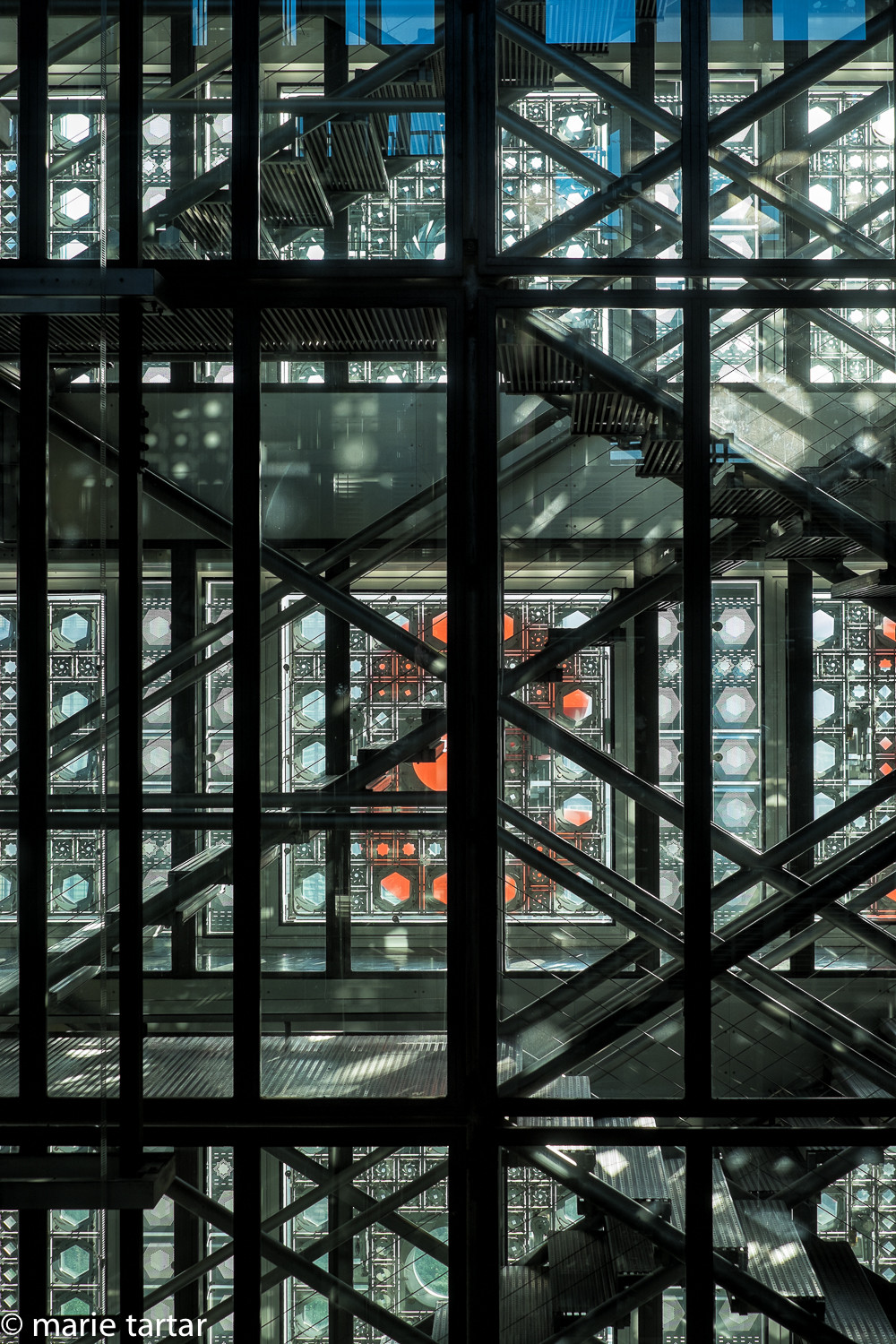
Monde d’Arabe is a visually stunning design by Jean Nouvel; a patch of blue sky and Charlie Hebdo red lettering contributed to this Mondrianesque composition of the interior staircases and the facade

The facade of Monde d’Arabe is composed of these louvered shade building blocks;. The idea was to be able to modulate the light. Although the mechanisms have mostly failed, the net effect is still effective.

This banner-like effect resulted from a recent addition to Monde d’Arabe’s facade:in giant red letters, in Arabic and French was the message “Nous sommes tous Charlie (We are all Charlie)”
From there, we walked over to Monde d’Arabe, just for the views up top, before catching the RER a few stops to get us closer to the musée Galliera, for the Jeanne Lanvin show. What a lover of embroidery and embellishment she was! The workmanship was incredible. By now, my feet were protesting vociferously. Tokyo Eat across the street was as far as I could hobble. We both enjoyed the cuisse de canard parmentier, a duck shepard’s pie, with mache salad.
Friday, March 14, 2015
Today was organized around lunch with Chandra, a friend from my book club at home, arranged for noon near Notre Dame, at Paris-Your-Way Margie’s recommendation, Le Reminet. She had suggested booking it through the website, La Fourchette (The Fork), which sometimes offers discounts. To my delight, the discount offered (drinks excluded) was 50%!
Before heading across the Isle to lunch, I was determined to not spend the entire morning in the apartment puttering. I did make it into the nearby free and fascinating Musée Carnavalet (Paris city museum) for a short while, but those delightful shops between the apartment and the museum interfered with my well-intentioned plans!
Le Reminet was small but welcoming and comfortable, a real delight. We thoroughly enjoyed our lunches. I chose the scallops à la plancha, with butternut risotto with Grana Padano, served with hazelnuts, shallots and lemon preserve, while Chandra elected the homemade smoked salmon, green peas and watercress purée with garnish of mushrooms. We decided to share the cheese plate (a nice green salad and a selection of 4 cheeses from Laurent duBois ) and dessert (a dark chocolate ball encircling a fig poached with Pineau des Charentes, with creamy semolina with mascarpone cream and Earl Grey mousse). The perfect mix of savory and sweet to finish an excellent meal, which was an unbelievable deal at 62 E for two, with the 50% off already subtracted. We actually gasped (in amazement) when the bill came. A new favorite!
After lunch, I walked north to Republique to meet Patricia.

A glorious fall day in 2011 along the Canal Saint-Martin; my brother-in-law Jason is in red in the center of la passerelle (footbridge)
We were heading to La Villette for an opera in the evening, and recalling a walk Steve and I enjoyed years back with Clarissa and Jason along the canal, we had decided to walk northeast.
 Along the way north on Blvd Beaumarchais, I ducked into a couple of camera stores, seeking a remedy for my increasingly precarious battery charging situation (as in, I decided to top off a battery at home and left without a charger and was on the last battery).
Along the way north on Blvd Beaumarchais, I ducked into a couple of camera stores, seeking a remedy for my increasingly precarious battery charging situation (as in, I decided to top off a battery at home and left without a charger and was on the last battery).
By the time we reached the Geode, the huge silver ball which houses the Imax theatre, I was again happy to be off my feet and vicariously soaring and rafting through the Grand Canyon, cinematic reenactments of several favorite trips past. The idea of going to a concert up here had been mine, prompted by the opening of a new concert hall which looked to be another architectural wonder of Jean Nouvel.
In this, we were somewhat thwarted, as our tickets for Rossini’s Le Voyage à Reims proved to be in an adjacent building. The performance, by conservatory students and faculty, was well sung and received by an appreciative audience.
Samedi, 15 mars, 2015
After decompressing at the apartment after a later than usual night, and catching up with Steve on the phone, I was not up particularly early. Patricia and I met up early afternoon at the Opera House at Bastille, near the start of the Promenade Plantée, the elevated railway-turned-park after which NYC’s Highline is modeled.
Steve and I had really enjoyed walking this route on a prior trip. It places you up at the level of the trees, better able to admire architectural details of the buildings en route.
The mild spring weather was holding and trees were in various stages of budding and blossoming. We went the entire length of the promenade, ending near the Peripherique, at the Palais de la Porte Dorée, housing the Musée de l’Histoire de l’Immigration. We were drawn by a show called Fashion Mix: Mode d’Ici, Createurs d’Ailleurs (Fashion from here, creators from elsewhere), showcasing the work of international fashion designers who made Paris their proving grounds or bases. This show was produced in conjunction with Palais Galliera, the fashion museum. Walking and fashion: that’s actually how I met Patricia, on a fashion walk with Paris Walks, showcasing the luxury goods industry in and around Palais Royale. Gorgeous and outlandish outfits, and amazing workmanship, from 1880 to the present were highlighted, in an interesting celebration of an industry which has been greatly enriched by immigration.
After a restocking stop at 134 RdT, I was off to Beaubourg, or the Centre Pompidou, to meet our artist friend, Milène Guermont. I managed a quick perusal of the small but interesting show “Qu-est-ce que La Photographie?, ” or What is Photography? This was downstairs in the newly opened and free Galerie de photographies. My attention was diverted from the large and colorful canvases of Hervé Télémaque by my throbbing feet by the time I met up with Milène. We were “encouraged” out of the galleries by the attentive security guard, who pointed out there was a petite salon where we could catch up. I was only too happy to decamp to nearby Café Beaubourg, where we warmed ourselves with vin chard on the heated and sheltered terrace.
Milène is on a white hot trajectory professionally, and it was wonderful to see mockups of her upcoming projects, including a still-under-wraps, but quite monumental undertaking in a very prominent Parisian focal point. She combines an engineering background with artistic training and unusual reserves of energy and ideas, as well as stints in industry designing for the likes of Rolex, with a love of texture and materials, combining “polysensual” concrete with sound and lighting, to great effect.
Sunday, March 15, 2015
Sunday was a colder and grey day, a more typical March day, still not cold enough for a hat, but requiring zipping up my jacket! As befits a Sunday morning, I took my time stirring, did a little laundry and considered my options. Patricia invited me to lunch at 1 pm, but I had just eaten at that point and started the washing machine, so I declined. I did make the happy discovery I would not have to buy another camera battery charger-I searched my camera bag one last time, and discovered, not the charger, but 4 more batteries, enough for each of my remaining days! Saved!
I opted to stay local, and headed to nearby MEP, Maison Européenne de la Photographie. It is housed in an hotel particulier with a staircase I can never resist photographing.
Out front is a Japanese rock garden by Keiichi Tahara, called “Niwa” (Japanese for garden!).
The exhibits were interesting as usual, including 2 as-different-as-they-could-be bodies of work by Grégoire Korganow. In the windowless, somewhat claustrophobic, lower-level galleries were images from his Prisons series, which was as cheery as that sounds. His Père et Fils series was just the opposite: moving double portraits of men and their sons, bare torsoed, with subtle clues to their relationships and personalities implied by their expressions, body postures and resemblances (or lack of). I found the L’Italie de Bernard Plossu exhibit pleasant if pedestrian, while the Éric Rondepierre show was more interesting and challenging visually, with the actor/photographer mining cinematic film for stills degraded by age or heat, or other visually interesting accidents.
As I was heading to the Metro to go to Parc de la Villette, I made a most welcome new discovery: tasty and fast food near Place des Voges. Giraudet specializes in quenelles (an oval dumpling-like mixture of creamed fish (or meat) with an egg binding, which can be poached and is often served with a sauce), which can be eaten there or picked up for heating at home. I had a quick warming, very tasty “vegetarian” soup there of lentils, chickpeas and lamb.
Despite having just been there with Patricia, I made an unnecessary change to an RER and disembarked at the wrong station, Pantin, instead of the metro station right next to the concert hall, Porte de Pantin. They are not far from each other (I saw the nearby science museum as the train pulled into the station), but I was close enough to the start time and the park is big enough that a wrong turn would mean a late arrival. And I had had a powerful demonstration several nights before how French audiences are all in their seats well before the curtain time, no dilly-dallying until the last minute, pas de tout! Thankfully, I asked a woman at an intersection if she knew the neighborhood and the quickest way to the concert hall and she replied she was walking that way and it was only about a 15 minute walk…we had a nice conversation en route through the park, and I slipped into a seat just as the lights dimmed for the dance concert, set to Stravinski’s Le Sacre du printemps (appropriately enough, the Rite of Spring).
Monday, March 16, 2015
Paris by Mouth’s Meg Zimbeck herself welcomed us to the Japanese Knife Store, across from the closed-on-Monday Marché d’Aligre.
In the rear of the store was a U-shaped bar, set up for 9 of us with glasses, and a baguette each, with platters of cheeses to be tasted, aligned at the ready. After introducing ourselves and a welcoming glass of Loire Valley sparkling wine, we were off on a marathon of cheese (and secondarily, wine) tasting. And I do mean a marathon: 3.5 hours, 17 cheeses, including 5 young chèvre and brebis (sheep) soft cheeses, 2 soft-ripened bloomy rind cow cheeses (I loved the brie de Meaux!), 2 uncooked and pressed cheeses, 3 cooked and pressed cow cheeses (including my favorites, comté (at 20 and 40 months) and mimolette), 2 washed rind cow cheeses (the stinky kind, including a new favorite, Epoisses), and not one, not two, but three blue cheeses! These were paired with 7 wines and a beer. Some pairings had a geographical theme, while others were selected with an eye toward balancing acidity. There were offerings which were completely new, and some completely surprising. In the new category was a pairing from Corsica, a soft sheep cheese, Brin d’Amour, paired with a vin de France (VdF) from established vintner Antoine Arena, using Bianco Gentille grapes, a variety thought to have died out.

Among the “students” in this course was a pro: Martin is the sommelier at a restaurant in the 20th, Roseval. I didn’t make it there this time, but sounds intriguing for next time!
In the surprising category (at least for me) was how well pungent washed rind cheese, like Epoisses from Bourgogne, is washed down with beer (a Milliacus amber beer from Picardie, in the north of France). One of the more unusual wines we tasted was a Côtes du Jura 2011 vin de voile from Domaine Labet, made with Chardonney and Savagnin. It had a distinctive, sherry-like character imparted by the “voile” (veil) element: a fungus. This is a “classic” pairing with Mimolette, but it may take a few more samplings to convince me this is the best possible pairing for one of my favorite cheeses.
Meg has a background in public health, and we learned much about cheese in general, including the science behind cheese production. I never really thought of cheese as essentially a way of preserving milk in solid form through winters of centuries past.
Before we knew it, we had run over time and I had to tear out to meet Patricia at the Pinocothèque, for the Gustave Klimpt show. I made it just as she reached the head of the line. We had plenty of company (many museums being closed on Mondays), but it was well worth jockeying a bit for position to see works by Klimpt and his contemporaries before heading back to Parc de la Villette for the evening’s concert.
The concert hall was transformed from the prior evening-shrunk by at least 2/3rds, into a square configuration surrounding the orchestra.
Having opted for less expensive tickets (17 E), we were at a disadvantage in some respects. We had a wonderful view of the orchestra, arrayed in a semi-circle, with some performer’s backs to us. On the other hand, I’ve never seen the conductor better! The performance of Berlioz’ Romeo and Juliet included choral performances, as well as solos, so where the singers were positioned affected our appreciation of their tonalities. This was most acute during Romeo’s final solo. I didn’t really expect to understand the sung lyrics, but certainly wasn’t helped by the fact the supra-titles were above and behind us. I would estimate fully a third of the audience would have had difficulty seeing them without excessive neck swiveling. I wondered if there are plans to add an additional set of supra-titles for configurations like this. As far as we could tell, the website did not indicate any obstructed sight lines on booking.
Tuesday, March 17, 2015
I spent a restless night with an unwelcome visitor. I wasn’t sure what to implicate but evidently, my GI tract was sending me clear signals that something I was injesting was trop, too much! My Pepto-Bismol stocks being dangerously low by morning, I was searching the web for the French equivalent, only to learn that it isn’t readily available. Prepared Patricia came to my rescue, with a security blanket of additional capsules, just in case, and off to the Musée d’Orsay we went. I hadn’t been there since 2009, but it truly is a wonderful transformation from a glorious train station to a magnificent temple of art.

In 2009 in this beautiful dining room at Musée d’Orsay, I first understood the power of language. Being able to tell the waiter my fish was “trop sec” resulted in the charge being removed from the bill!

A beautiful new dining option, Café Campana, at musée d’Orsay, designed by les frêres braziliens, Fernando and Umberto Campana. The delicious Thai chicken soup went a long way toward restoring my electrolytes!
We managed to spend all afternoon au musée d’Orsay, just making it through the special Bonnard exhibition by closing time. There was golden afternoon light beckoning us into the Tuileries and into those inviting chairs at Le Grand Bassin Rond.
We made our way slowly through the Left bank, en route to dinner at Le Reminet with Jann (another friend from my book club), including an introduction to the ultimate cabinet of curiosities, Deyrolle. However, Jann was awaiting the call saying her lost luggage was being delivered and didn’t end up staying for dinner in the lower level dining room, where the thick stone walls didn’t permit cell phone reception. Patricia and I had a wonderful meal, she enjoying the scallops I had liked so much before and I placating my GI tract with filet of sole.
Wednesday, March 18, 2015
I met Patricia at the Musée des Années Trente, in the west of Paris in Boulogne-Billancourt, a prosperous appearing enclave with Art Deco post office and city hall, and a past enriched by being previously inhabited by many artists and architects of note, including Abel Gance, Le Corbusier, Jacques Lipschitz, Juan Gris and Jean Renoir. It is well worth a visit, with sections devoted to Art Deco furnishings and industrial design, art inspired by colonialism, and marvelous paintings and posters of the era. We spent several leisurely hours there, before Patricia headed off for her weekly tennis game and I headed to rue de la Pompe, where I saw a most welcome sight, a nail salon with immediate availability. This was right next door to my actual destination, Reciproque, a high end dépôt-vente. Having a manicure and pedicure probably saved me quite a bit of money, as it cut significantly into my time for browsing at Reciproque. I resisted the lure of an Alaïa dress, but did find two shoe-venirs: a pair of bright red patent Prada sneakers.
For the first time in ages, I became completely turned around exiting the Odeon metro, making me late to meet Jann for dinner at Le Méchoui du Prince. We shared and thoroughly enjoyed a tajine of lamb with apricots and almonds, and a vegetable cous-cous, after starting with a chicken pastilla. Towards the end of the evening, I returned from the restroom to find her very engaged in conversation about the merits of the current king of Morroco (vs. his father) with a handsome immigrant from there, a member of the next table foursome. I had come prepared for the walk home, with a longer lens (200 mm) to shoot the gargoyles, lit up at Notre Dame, on the walk home.

Notre Dame is well lit at night; walking home from dinner one night inspired me to return the next night, armed with a longer focal length lens
Thursday, March 19, 2015
Le dernier jour a Paris: I scored a mini-coup by arranging access to a Paris site neither Patricia, who has lived in Paris for 6+ years, and Jann, who has spent multiple stints in Paris of months-to-a-year, had ever been. While in Japan the prior October, Steve and I experienced firsthand the monastic quality of the predominantly concrete architecture of Japanese starchitect, Tadao Ando. A typhoon snafu forced us to cancel a planned visit to the Japanese studio of one of my other heroes, Isamu Noguchi, but I knew there was a Noguchi garden and an Ando meditation space at UNESCO. The question was, how to get inside? Especially after Charlie Hebdo, it didn’t seem likely we could just drop by. More-than-the usual amount of Internet detective work, by both me and Patricia, as well as email inquiries, led nowhere. The day before, I found a phone number and decided to call it. After explaining I was an architecture enthusiast, etc, I was transferred, but the phone rang and rang. Just before heading out for the day, I called again. This time, there was a friendly woman who responded that there was group tour at 11 am the following day in French which we could join, and what were our names? Sadly, they didn’t have staff for an individual tour, etc. We were in!
The morning was cold and cloudy, the first day that really felt like a typical March day. The group of seniors from Dijon we were joining was late, but eventually we were all ushered into Salle 1, where an Indian delegation was taking a tour. Our guide explained the mission of UNESCO, which can be distilled into one overarching goal: promotion of peace. The artwork within the complex incorporates symbols reflecting this charge. This includes a huge Picasso wall piece, based on the fall of Icarus, notable both for being the world’s largest Picasso and for being unsigned-apparently, Picasso did not approve of its placement. Outside were sculptures by Henry Moore and Calder. I had no idea if the Noguchi garden would be a tiny component of the grounds, but it proved to be a major work.
The guide pointed out that it intentionally evokes a traditional Japanese garden, but with distinctly non-traditional features, reflecting the global focus of UNESCO.
This extended to the plant selection, including a large American (specifically, not Japanese) pine. An interesting section featured a small, chipped angel’s head sculpture imbedded in a wall, the sole surviving fragment of a church destroyed by the bombing of Nagasaki. Arrayed in the area below was a grouping of concrete stools, arranged to evoke a tea ceremony, promoting the idea of a meeting of minds, with a quiet reminder of the consequences of war overlooking. Even the selection of Noguchi to design the garden seemed imbued with symbolism: being Japanese-American, and a sculptor; that is, an artist and not a landscape designer.
Just off from the Noguchi garden is the meditation space by Tadao Ando from 1995, commissioned to celebrate the 50th anniversary of UNESCO. The monastic cylindrical space is built of his characteristic concrete, completely unadorned and furnished only with a few chairs. The rim of light surrounding the ceiling is the most interesting feature.
This meditative space seems an appropriate place to close this long post. Paris continues to be for me an inexhaustible treasure trove. No matter how many times I go, there are always new discoveries to be made and visual, aural and gustatory pleasures to savor.
À bientôt!
-Marie
To see more of our images, click on this link








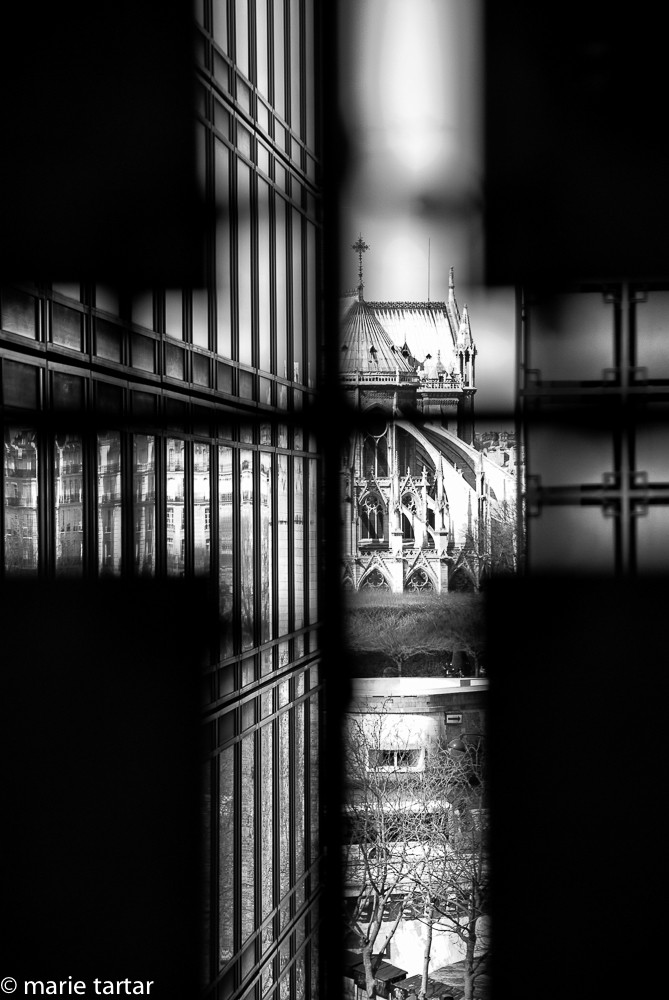



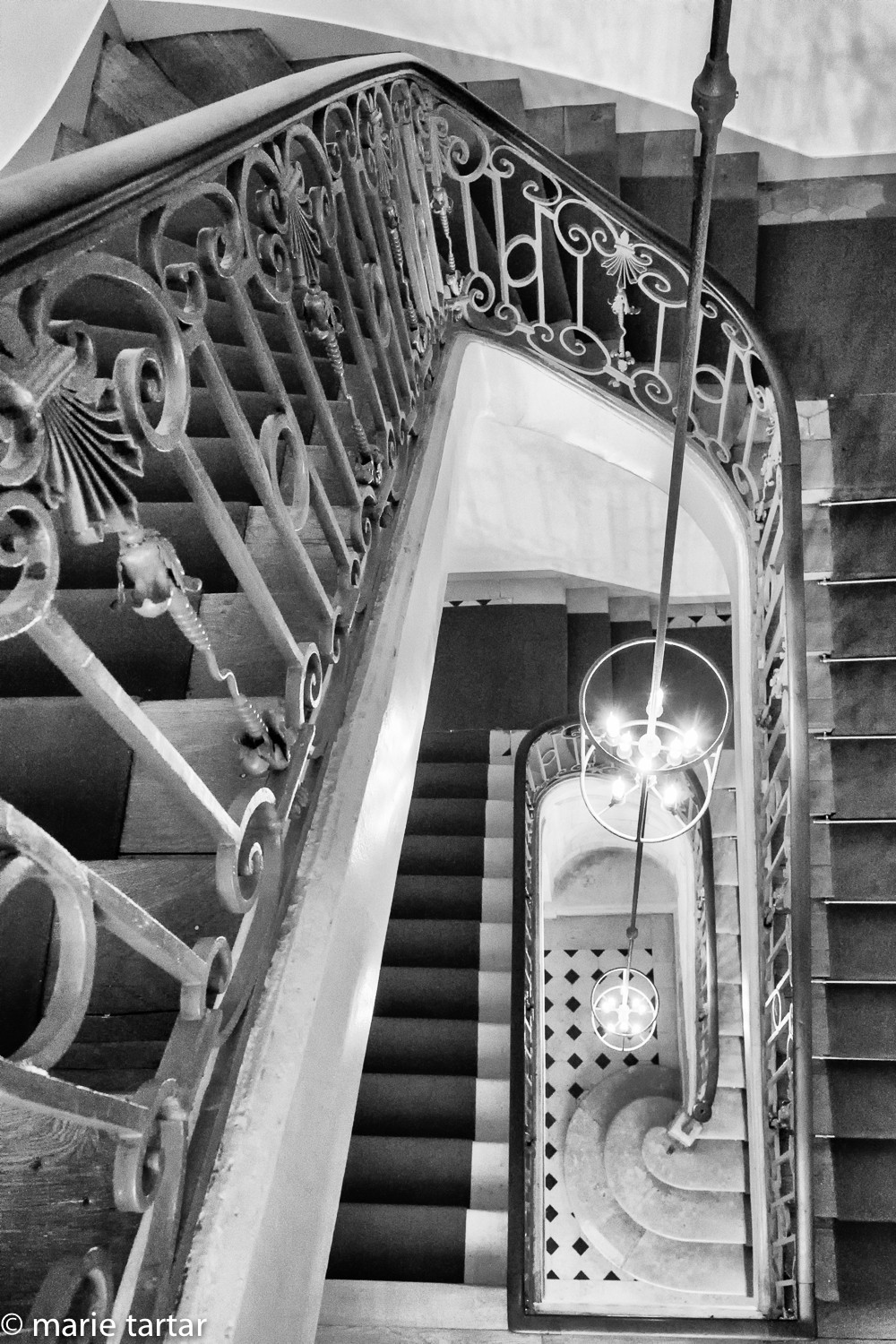


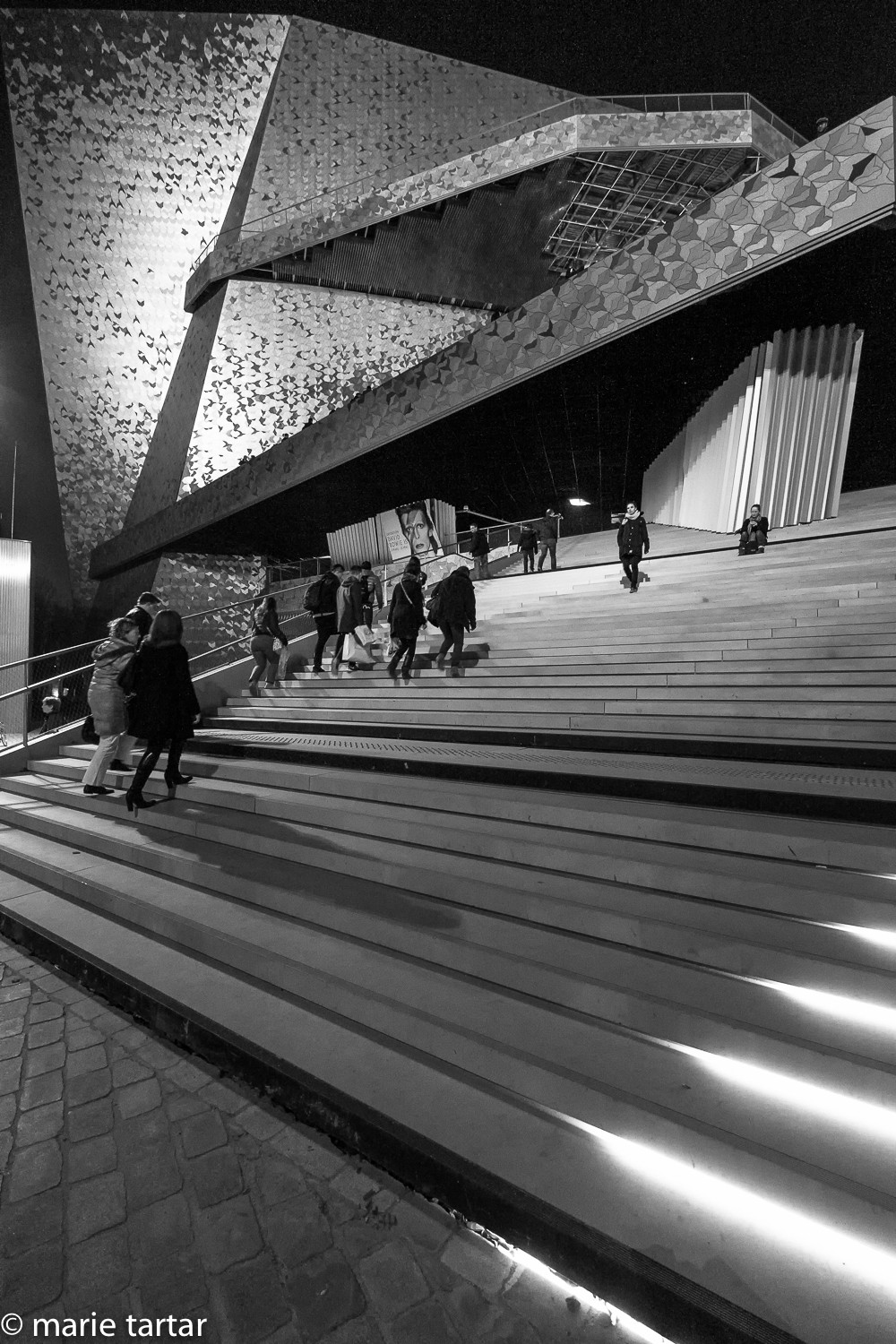
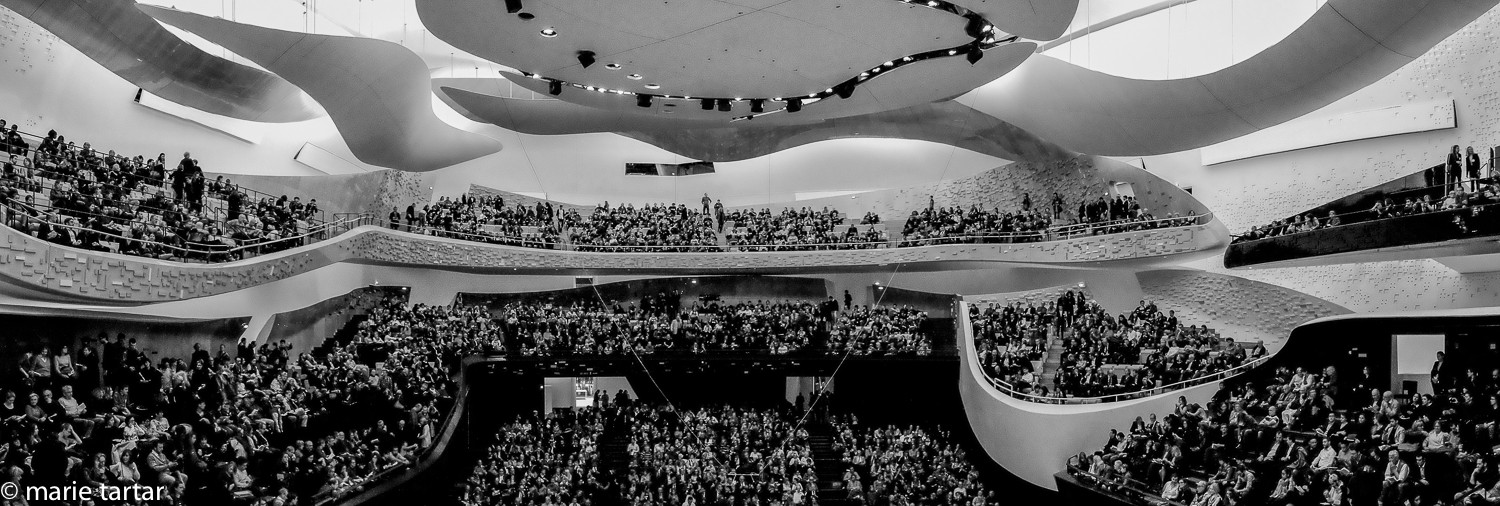
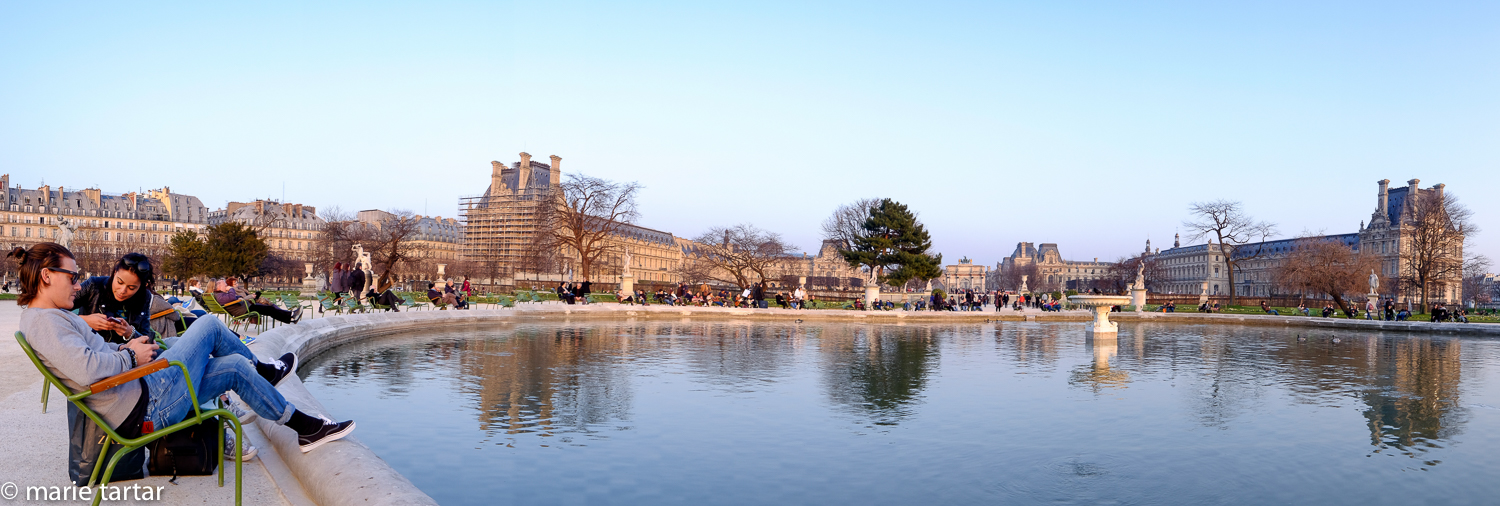




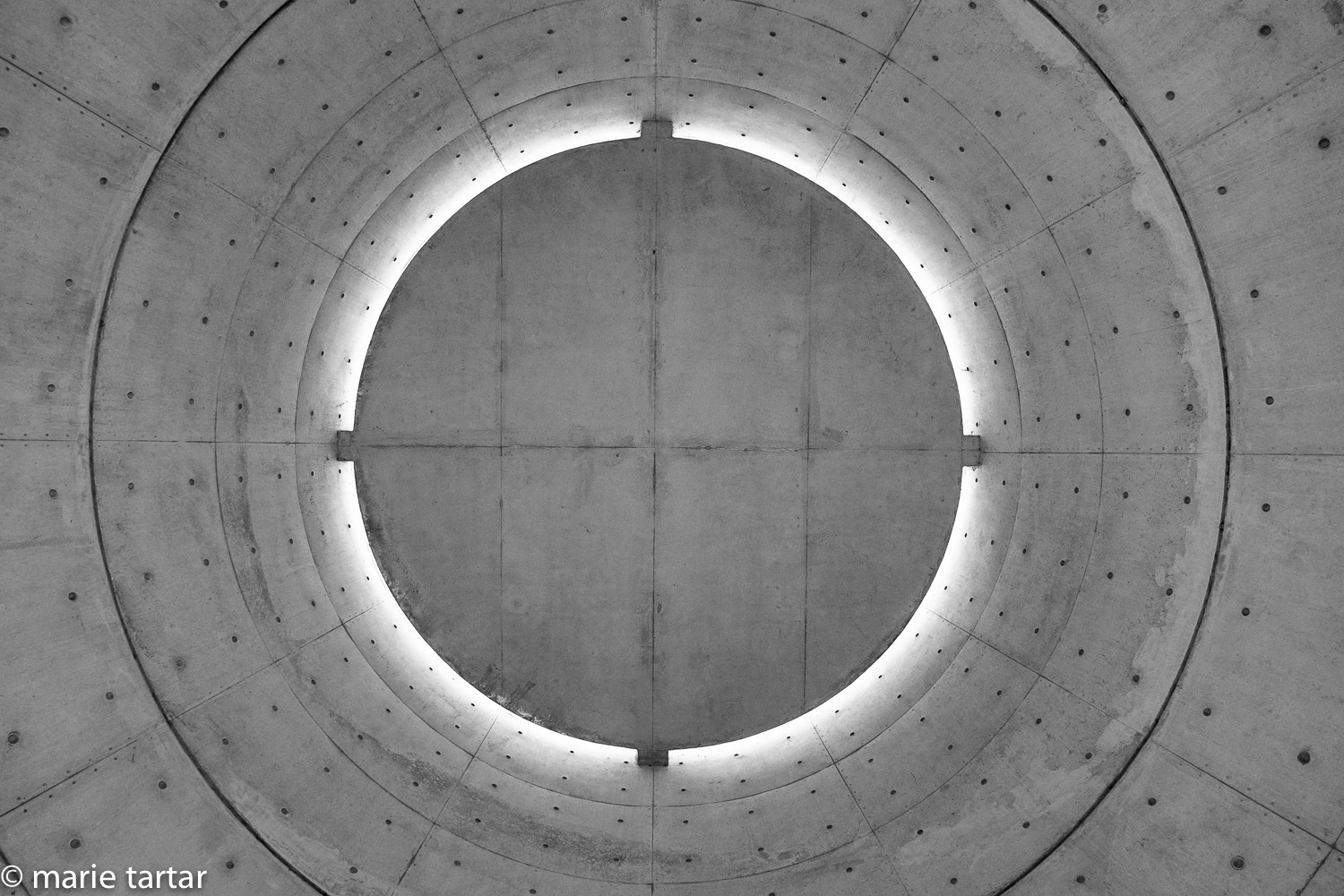
Always a pleasure to wander around Paris with Marie, then relive through her stories and photos.
wow!l what i missed! great photos and text…and yum!
Ohhhh! Why are we not there too! Fabulous photographs, especially of all the things we love….ART, FOOD, WINE, MUSEUMS, PEOPLE.
Thanks for sharing! Renée
(we just got back from Marrakech)
My first visit to Paris was in 1978 as a student living on the left bank in a 10 franc a day room with a room mate and un chambre down the hall . I was there for two weeks with my new degree in Anthropology rooming with a recently vintaged masters in archaeology French speaking Australian. These were the days that Paris on $10 per day were possible. Your narrative reminds me of that trip in the all the sights, sounds and tastes of Paris that you evoke. Thanks for sharing!
I was hoping to see the red patent leather Prada sneakers.
I loved the meditation space and your gargoyles. The moldy wine sounds fun, I think.
… love experiencing life vicariously through you!
Hi Marie, I really like your photos of the apertures in the facade of the Institut du Monde Arabe. What particular lenses do you use with your XT1?
Hi Donan,
Thanks! I have quite a few, but on that trip I used the 10-24mm, a 35 mm fixed, an 18-55 mm and a 55-200 mm zoom. For those images, I used the 35 mm fixed, which is a very nice, small and sharp lens, great for walking around all day and into night (it’s fast too, f1.4!). Depending on the trip (wildlife, landscape vs. city), I might use a weather sealed, heavier & more expensive 50-140mm. My husband likes the 23 mm fixed for street shooting, so much so that I don’t have too much experience with it!